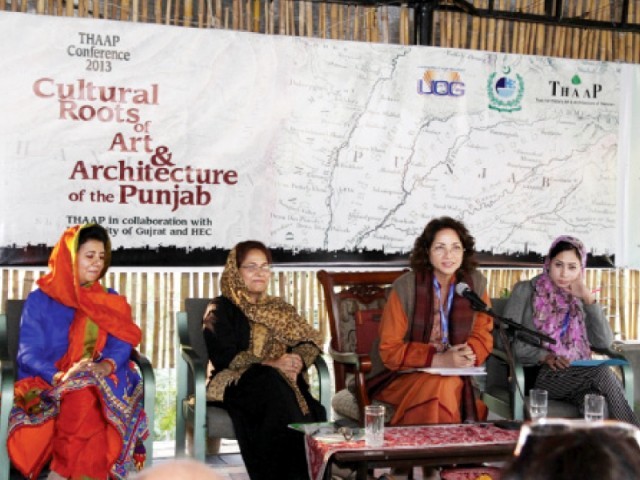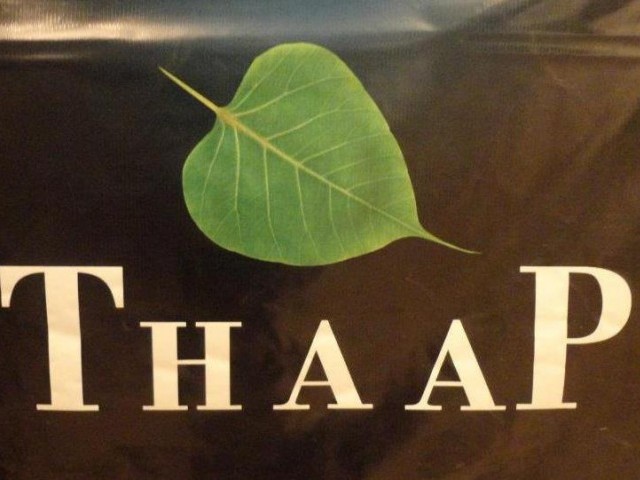|
THAAP Conference: ‘Parents no longer speak Punjabi with children’
By Hassan Naqvi

The session concluded with an art exhibition titled Drawing From the Land.
LAHORE:
“Heer is not just a character, it is a movement…we must understand our roots before exploring western feminism,” said Fakhra Hassan. She was reading her research paper, The Intellectual Revival of Punjabi Feminism, at the third session of the THAAP Conference on Cultural Roots of Art and Architecture on Friday.
Hassan said the youth should read Punjabi literature and revisit the masters who had inspired many foreign writers.
“Heer Waris Shah was based on real people with actual values…we must understand them,” she said.
Biographer Rajmahon Gandhi said Punjabi was one of the most concise languages in the world. “It is the language of the soil,” he said.
In his concluding remarks, Dr Ishtiaq Ahmed, a professor at Lahore University of Management Sciences said Punjabi was once spoken at homes. “Parents don’t converse with their children in Punjabi any longer…this is unfortunate.”
He said the country’s ruling elite had disowned the language of the largest ethnic group. “I believe the Punjabi bureaucracy is responsible for this. They have abandoned it,” he added.

Sadia Kamran Pasha, a visiting teacher at Kinnaird College for Women and Beaconhouse National University presented paper titled Tracing the Development of Bahawalpuri Kundan. She said the exact origins of the kundankari technique were not known.
“It is reported to have been in practice for centuries, with little variation, in western Asian civilisations and in South Asia.”
“The techniques, the forms and designs, the motifs and their symbolic values in kundan jewellery speak of the ancient cultural, economic and social ties between these civilisations,” she said.
Pasha said her study traced the roots of Bahawalpuri kundan technique and jewellery. She said it also recorded different phases of its growth as well as the technical variations since the Mughal era. “The difference between the original or pakka kundan and the contemporary thappa kundan is also recorded.”
The third session was presided over by Nadhra Shahbaz Naeem Khan from LUMS. It concluded with an art exhibition at 39-K titled Drawing From the Land.
Talking to The Express Tribune, Abdullah Qureshi, one of the curators at the gallery, said Drawing From the Land was a visual response to the fourth International THAAP conference.
Qureshi said the topic was Cultural Roots of Art and Architecture in the Punjab. For this, he said, an open call was sent out. “We received 31 applications in all forms and disciplines…this made the selection even more difficult,” he said.
Rakhshanda Atawar, another curator, said, “Through our selection we wanted to highlight the diverse engagement of artistic material that came forward.”
She said she hoped that a deeper connection could be formed between visual artists, researchers and scholars through the initiative. The participating artists are Rabia Ajaz, Habib Akram, Mehri Imani, Julius John, Fazal Rizvi, Jeeti Singh, Rabbania Shirjeel and Imrana Tanveer.
Published in The Express Tribune, December 7th, 2013.
THAAP conference: ‘Mughal art transcends traditional media’

Papers reviewed Mughal miniature art, the evolution of courtyards, architectural transformations in Punjab, the loss of Punjabi language and the sacred roots of Punjabi culture. PHOTO: facebook.com/Thaap
LAHORE:
The discourse on language, culture, arts and architecture continued on the second day of the Trust for History, Art and Architecture, Pakistan’s (THAAP) conference.
The papers presented on Saturday reviewed Mughal miniature art, the evolution of courtyards, architectural transformations in the Punjab, the loss of Punjabi language and the sacred roots of Punjabi culture.
Participants came from the Lahore University of Management Sciences, Kinnaird College for Women, Indus Valley School of Art, the University of Engineering and Technology Lahore, Punjab University, the University of Gujrat, the Beaconhouse National University and the National College of Arts.
Aqsa Yasin and Bazla Manzoor of Bazal Associates presented a paper titled Evolution of Courtyards in Central Punjab – Pakistan. Their study focused on Sardar Saheb Haveli, near Chiniot. Yasin, a young engineer, and Manzoor, an architect, spoke about the architecture of central Punjab and the functional features of courtyards. Yasin said the architectural concepts of the province were not limited to it. The region had adopted several concepts introduced by its invaders, she said.
Many architectural concepts in central Punjab, which includes Jhang, Faisalabad, Khanewal, Sargodha and Toba Tek Singh, are unique, she said, but are not completely detached from architecture in the rest of the province.
Courtyards of structures in central Punjab offered their residents open spaces within the building, as well as natural ventilation, said Manzoor. “But their greatest use was to provide privacy for household women,” she said. In view of cultural and religious norms of the region, the courtyards offered women an open air venue where their privacy would not be compromised.

Discussing the architectural features of Sardar Saheb Haveli, Manzoor said the courtyard constituted almost 33 per cent of the building’s area.
Osama Ahmad, an undergraduate student and research associate at LUMS, presented his paper on Punjab’s Architectural Transformations. The paper covered Indo-Greek classicism to British Colonial neo-classicism era. Ahmad spoke about the famous Montgomery and the Lawrence Halls in Lahore. The two structures, he said, now called the Quaid-i-Azam library, were initially used to host state events and balls. The two halls were constructed by G Stone in the late 1800s. The grand structures intended to reflect the grandeur of the Raj.
“Expressions of Mughal art have gone beyond the canvas,” said Abdullah Qureshi, artist and curator of the 39-K Art Gallery. His paper titled The Space of the Mughal Miniature focused on the shifting boundaries of paintings in the region. Qureshi said the boundaries had expanded physically and conceptually. Artists did not confine their expression to paint and canvass but took on various media. “It has transcended its physical space with artists now using sounds and their bodies to recreate the Mughal space,” he said. “Kathak dance and classical music had been used for that purpose.”
Dr Tariq Rehman’s paper How Punjab lost its Punjabi received loud applause. Rehman said while Punjabi was still a language of business, it had failed to receive political grounding. “It could be because Punjab lost much of its territory to India,” he said.
Responding to a query, Dr Rehman said Punjabi would have to be taught in schools and used on a large scale for any progress in this regard. “When children are schooled in a certain language it helps generate greater understanding and awareness of the language,” he said, “but this must be practised across the board, especially in elite schools.”
Pakistan’s culture was not that different from other postcolonial cultures in that it lay at an uneasy cross-section of two cultural currents – modern and traditional, said architect Taimoor Khan Mumtaz who read a paper on The Sacred Roots of Culture in Punjab.
Khan, an architect at the Kamil Khan Mumtaz Architects, said every individual had multiple identities based on different markers including language, religion, geography and ethnicity.
THAAP Conference: ‘The Mughals knew the importance of GT Road’
By Hassan Naqvi

“GT road enters Pakistan at Khyber pass, passes through mountains, plateaus and plains, covering over 1,600 miles, ending at Sonar Gaon in Bangladesh,” says Architect Hussain Abdul Rehman Qazi. PHOTO: FILE
LAHORE: Papers on topics including timber techniques used by artisans in Chiniot and Gujrat, and common roots of Irani and Pakistani handicrafts were presented at the evening session of THAAP conference on Sunday.
Architect Hussain Abdul Rehman Qazi read one on the Grand Trunk Road.
He said the GT road was a vital link between India, central Asia and Europe. “It enters Pakistan at Khyber pass, passes through mountains, plateaus and plains, covering over 1,600 miles, ending at Sonar Gaon in Bangladesh.”
He said the route had always received attention from Indian rulers. “It was extended by Sher Shah Suri to Narayangang district in Bangladesh – the eastern end of his empire.”
Qazi said, “Chandar Gupt Mauria’s grandson, Ashoka, had planted trees along the historical route.
“Akbar restored it [the road] to its former glory…the Mughals understood its importance for governing their vast empire.”
Architect Ali Arsalan Pasha presented a paper titled Molding the Red Earth. The paper, tracing the link between Africa and India, was dedicated to Nelson Mandela.
Pasha said all great ancient civilisations flourished along rivers.
Earlier, Architect Sahar Saqlain presented a paper titled An Evaluation of Timber Techniques practiced by Artisans of Chiniot and Gujrat.
Saqlain showed pictures of work done by Chinioti artists at Umer Hayat Mahal in Chiniot and the tomb of Hazrat Shah Burhanud Din Bukhari at Shadi Malang.
Taranah Yalda, an architect from Iran, talked about common roots of Irani and Pakistani handicrafts.
Published in The Express Tribune, December 9th, 2013.
THAAP conference: ‘Common sense must trump our differences’
LAHORE:
Discussions on communal harmony in the sub-continent, traditional crafts of phulkari and bagh, significance of water in the preservation of culture and a discourse on public parks and gardens engaged the audience on Sunday at the Trust for History, Art and Architecture Pakistan’s office in Lahore.
Academics and architects deliberated over the history and culture of the Punjab on the third day of the conference.
Professor Rajmohan Gandhi, historian and research professor at the Centre for South Asian and Middle Eastern Studies, University of Illinois, spoke about how sufism focused on the commonalities between religious groups in the sub-continent. In his paper, Clash vs Common Sense, Dr Gandhi said that there was a continuous dialectic between, what he termed, ‘clash’ and ‘common sense’ that shaped the culture of the Punjab. The clash focused on differences, while the common sense – used by most of the sufis – focused on commonalities. The sufis, he said, had convinced a vast majority of the population that humanity was a common denominator.

Dr Gandhi narrated anecdotes depicting communal harmony among people during periods of persecution of various religious groups in the subcontinent. He said just as there was a long tradition of clashes, there was a rich tradition of inter-religious solidarity, especially during trying times.
He said the triumph of humanity and common sense over clashes was important to heal the Punjab. Responding to a query regarding the lessons drawn from the Partition, Dr Gandhi said that history alone was not enough to bring about a transformation. “History alone will not provide a strategy or a backbone to help us learn lessons,” he said.
Parks for education
Public parks were not just intended to provide leisure but also education, Dr Ali Akbar Husain, head of the architecture department at the Indus Valley School Karachi, said. His paper, Revisiting Our Roots: A Stroll in the Lawrence Gardens, discuses the use of arboretums – gardens having a collection of trees designed in a way that helped people identify various trees.
One of the first botanical gardens, Dr Husain said, was cultivated in Calcutta. Most of the gardens in the Mughal era focused primarily on leisure, he said, the Colonial gardens focused both on leisure and scientific education.
He said after Partition, what with the establishment of the Parks and Horticulture Authorities, there was still much to be done. The lack of consistency and “ugly” labelling of trees marred public parks in the Punjab. “Botanical gardens have lost their purpose because people fail to understand their purpose. Ignoring gardens will only encourage anti-social behaviour in our society,” he said.
Tentage in Lahore
Tentage in Lahore: Continuation of the Mughal’s Tradition explored the ‘tent culture’ in the Mughal period. Beenish Tahir, head of the textile design department at the Punjab University, narrated the history of tents used during the reign of emperors Akbar, Jehangir and Humayun. She spoke about the materials [brocade and velvet] and decorative techniques [block printing] used for tents during the Mughal era. Red was used to distinguish the tents housing the royal family, she said.
Women and embroidery
Professor Jasleen Dhamija’s paper, Phulkari and Bagh: The Punjabi Women’s Creativity, explored the relationship between art and people. The paper was read out by THAAP joint secretary Aabidah Ali. The paper described the creativity of Punjabi women as boundless and free flowing. Creative expression in the Punjab was inspired by various invasions, the paper suggested. Girls were taught simple embroidery at a young age that gradually became more complex as they grew up. From wrapping newborn babies in embroidered cloth, using it as covering during adolescence to adorning themselves when they wed, Dhamija wrote, the craft was deeply rooted in the culture of Punjab.
River and Culture
River and Culture: A Bonding, a paper by Dr Amit Ranjan, explored how the “elixir of life” has transformed cultural ideas and life in the Punjab. Dr Ranjan said water not only contributed to agriculture but also to industrial revolutions. Rivers should be considered embedded entities and not just water bodies, he said. Several religious rituals involved water, he said, River Ganges was revered because of its religious symbolism. “Hindus relate the river with purity,” he said. “We must save our rivers to preserve culture.” Published in The Express Tribune, December 9th, 2013.
|